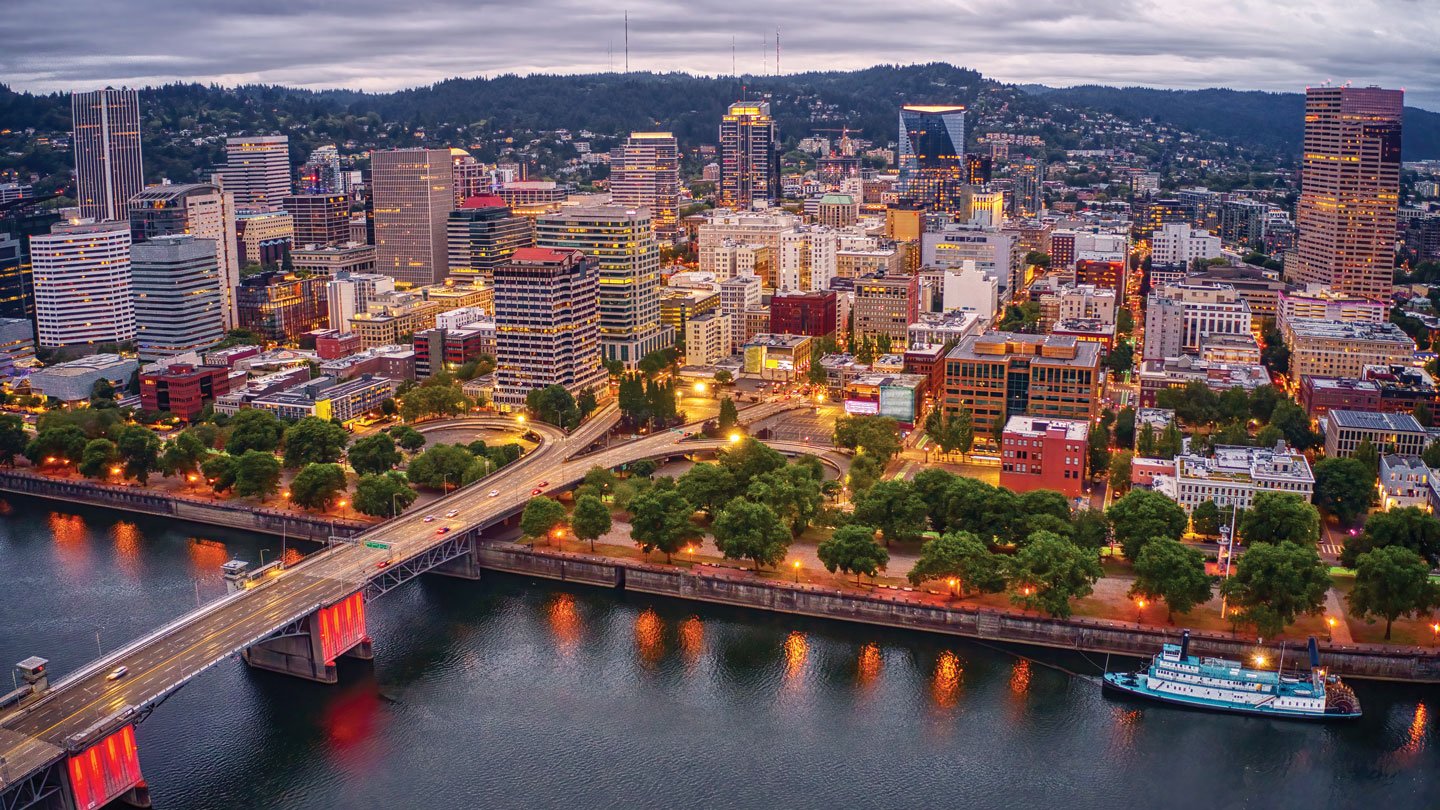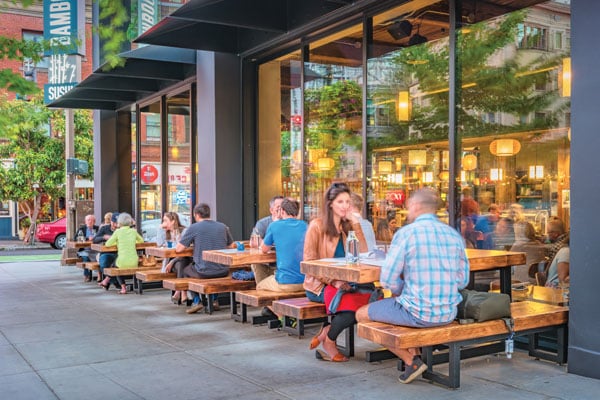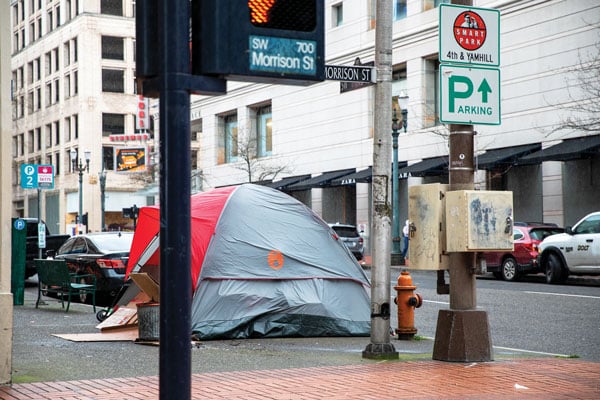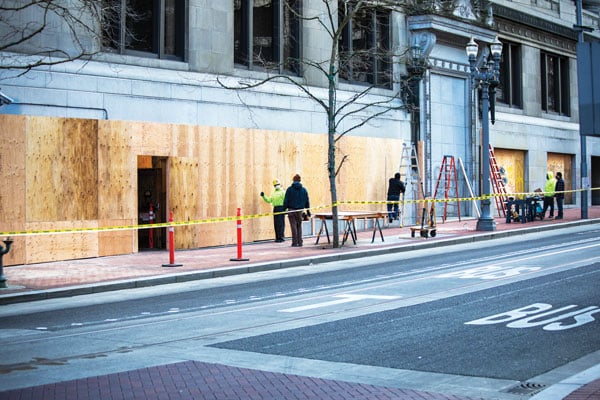
Bringing Portland Back From the Brink
A coalition of Oregon real estate organizations is working to change the city’s trajectory by influencing policy at multiple levels.
No American city has fallen as fast as Portland, Oregon, in the eyes of national real estate investors. In the 2010s, Portland was a beacon for investors seeking a secondary market that offered a high quality of life and high barriers to entry, potentially creating conditions for above-average rates of return. In 2017, Portland ranked third out of 78 markets for overall real estate prospects in the Urban Land Institute’s Emerging Trends report.
With the pandemic, the 2020 political protests, widespread homeless camping, and a flurry of regulations affecting real estate development, Portland’s reputation plummeted precipitously. By 2021, the city’s ranking had dropped to 66th out of 80 markets; this year it ranks 80th out of 81 markets.
This article discusses some of the conditions in the Portland market that led to its decline in rankings, describes the Portland real estate community’s efforts to revitalize the economy, and suggests strategies that leaders in other markets with similar issues can adopt.
The Growth of Regulations
Oregon’s land use regulations have been in place since 1979, following high levels of in-migration the previous decade. The system restricts urban development to identified urban growth boundaries (UGBs), which are established locally and approved at the state level. Outside UGBs, housing development is restricted to one or two dwelling units per parcel, with limitations on subdivision to protect farmland and forestry land.
In theory, each UGB is designed to accommodate 20 years’ worth of population and employment growth. In practice, local officials can assume high-density growth that minimizes the need to expand their UGB. For example, the Portland Metro UGB has expanded by only 15% in acreage over the past 45 years, while the region’s population has grown by 80%. The policy has increased land costs and housing costs. In the metro area, land prices are approximately 20 times higher within the UGB, with some variation by location. The Portland area’s median home price is $597,500, compared with a national median home price
of $412,400.
Land-extensive sectors of the real estate industry are most affected. Industrial real estate developers have been challenged in finding parcels to serve the Portland market, turning to exurban locations outside the jurisdiction of Metro (the elected government for the greater Portland area) for new development. Housing production has fallen considerably since the 1990s despite the increased population, with the greatest decline being in single-family homes, which use more land per unit compared with multifamily. Builders have adopted smaller lots, row houses and apartments in new developments.
Beyond the chronic issue of land constraints, Portland’s real estate industry has faced increased regulations, particularly in the multifamily housing sector. Some of these regulations were pioneered in Portland and later implemented or expanded statewide:
Inclusionary zoning (2016): Portland mandated that developments with 20 or more units include below-market-rate rents on a portion of those units, effectively acting as a tax on developers to fund social benefits.
Relocation assistance (2017): Portland landlords must pay tenants $2,900–$4,000 (depending on unit size) for large rent hikes (10% or more), no-cause evictions or lease nonrenewals.
Rent control (2019): Senate Bill 608 capped rent increases at inflation plus 7% (or 10%, whichever is lower) for buildings over 15 years old.
In addition, Oregon’s income taxes are already among the highest in the U.S. with rates up to 9.9%. This was further complicated by two new tax measures approved by Portland-area voters in 2020:
Measure 26-210: A 1% income tax surcharge and a business tax to fund homeless services.
Measure 26-214: An income tax increase (up to 3%) for high earners to fund preschool education.

Downtown Portland has struggled to recapture its vibrancy since the pandemic, with office vacancy rates remaining at 35% this past March. benedek via iStock Unreleased
With no sales tax and restrictive property tax policies, Oregon relies heavily on income taxes, making Portland less attractive for investment compared with nearby Washington state, which has no income tax.
The accumulation of new taxes and regulations has created a deep shadow over the Portland real estate market and economy. Housing supply has been restricted over a long period of time. Higher-density development is encouraged by permissive aspects of zoning in the region but often results in higher cost per square foot compared with two-story construction. In addition, higher-density construction is expected to contribute to social welfare benefits in the region due to mandates for below-market-rent apartment units.
From an economic development perspective, the higher income tax rates in Portland and, to a lesser extent, its suburbs have become a challenge. Recruiting talent in higher-paying professions such as medicine, law, engineering and professional athletics has become more difficult.
Economist Mike Wilkerson of the consulting firm ECONorthwest has argued the city has entered an “urban doom loop” where high taxes deter in-migration of higher-income households, homelessness and social disturbances in downtown Portland deter business recruitment and office occupancy, and declines in property values and taxes lead to reduced public services and amenities.
In the past five years, the population growth engine that supports the metro area’s economy has stalled. After years of steady population growth, Oregon experienced a decline of 30,000 people in 2021-2023. The only metro-area county to increase population was Clark County, Washington, although by a smaller amount than the Oregon counties lost.
The Pandemic, Drug Policy and Protests
Downtown Portland had been a major success story for the city. Using urban renewal and key infrastructure investments, Portland revitalized an industrial district immediately north of downtown into the mixed-use Pearl District, featuring bookstores, art galleries, offices, apartments and condominiums. Other efforts had also improved the South Waterfront District next to downtown and the Lloyd District immediately across the Willamette River. Downtown Portland was working toward creation of “18-hour districts” of walkable neighborhoods and a mixed residential-office population.
The pandemic reversed these positive trends. As office workers moved to online employment, the heart of downtown became depopulated. Portland’s downtown office market had one of the highest vacancy rates in the country, remaining at 35% as of March 2025.
During the pandemic, Multnomah County adopted a policy to support homeless residents living outdoors, distributing camping tents and tarpaulins to allow people to reside on downtown sidewalks, in parks and on vacant lots. This decision coincided with a November 2020 voter initiative aimed at decriminalizing possession of hard drugs, which resulted in the emergence of drug markets and criminal activities around homeless encampments. This policy remained in effect until the state Legislature recriminalized hard drugs in September 2024.

Under a policy adopted during the pandemic, camping tents and tarps were distributed to Portland’s homeless population, allowing people to reside on downtown sidewalks. Mark Youso via iStock Editorial/Getty Images Plus
Compounding the area’s distress were the riots following the murder of George Floyd in May 2020. This sparked nightly protests in downtown Portland, which further deterred office workers and apartment dwellers.
The combination of these dramatic events led to Portland becoming a symbol of an ungovernable city. While most area residents live outside of downtown Portland, the troubled conditions there severely damaged the reputation of livability the city had worked hard to achieve.
The Real Estate Industry’s Call to Action
At the annual Institute for Real Estate Management (IREM) Forecast Breakfast in December 2021, Portland real estate investor and philanthropist Jordan Schnitzer called on the real estate industry to reorganize itself to foster better ideas for governing the city of Portland.
Criticizing local politicians for failing to consult with the business community and improve conditions in downtown Portland, he encouraged the leadership of IREM, BOMA and other groups to hold a joint meeting and “develop a strategy together with an executive group to speak with one voice.”
Schnitzer’s invitation prompted those leaders to meet and plan for a new organization. According to Evan Bernstein of Pacific Northwest Properties, who was then president of NAIOP Oregon, “One of my goals as president was to collaborate with leading commercial real estate trade organizations such as CAB, IREM, SIOR, BOMA, CCIM, CREW and others to leverage our collective expertise. This aligned seamlessly with the formation of the Revitalize Portland Coalition (RPC), as we were already coming together.”
The coalition formed an eight-member board of directors, including representatives from NAIOP, IREM, CCIM and Multifamily NW, and established committees to recommend policies. To lead these efforts, RPC hired Erik Cole, a former elected member of the Nashville-Davidson County (Tennessee) Metro Council.
RPC adopted several aspirational “bright line” policy recommendations, including ending rent control, mandatory inclusionary zoning, local income taxes and unsheltered homelessness, and enforcing property crimes and laws on hard drugs.
Challenging Homelessness Policy
The first RPC event, in September 2022, was a symposium on homelessness that highlighted problems with regional policies. Panelist Alan Evans, founding director of Helping Hands, a homeless services provider, described the challenges of getting funding for programs that emphasize sobriety and work rehabilitation. Bob Day, who was later appointed Portland’s chief of police, explained how changes in policing policies since the 1990s had contributed to increased homeless camping.
Following that start, RPC joined other groups in challenging Multnomah County’s homeless services program, including its policy of distributing tents and tarps so that people can live on downtown sidewalks and allowing continued drug use by residents of homeless shelters. Drawing on policy models in Houston and San Diego, the coalition also called for ending “housing first” strategies in favor of focusing on shelters, vouchers and individualized rehabilitation strategies.
Reforming Criminal Justice and Drug Policy
When Oregon voters passed Measure 110 in November 2020, it legalized the possession of small amounts of hard drugs, including heroin, cocaine, methamphetamines and fentanyl. This legislation made it more challenging to enforce drug-selling crimes because users could not be compelled to testify against dealers. Additionally, since most shelters were low barrier and did not require identification, sobriety or income verification, active drug markets emerged in areas where homeless individuals were housed. This also made shelters less appealing to many homeless people who might have otherwise sought assistance.
The measure, advanced by the New York-based Drug Policy Alliance, was supported by Multnomah County District Attorney Mike Schmidt, who was elected on a reform agenda that emphasized targeting violent crime and less enforcement of property crime.
RPC responded by criticizing Measure 110, which many voters saw as an extension of Oregon’s relatively successful legalization of marijuana. Unlike marijuana, however, no legal markets existed for the production or sale of heroin, cocaine and other drugs, so criminal activity predictably increased. RPC’s work was complemented by an effort by leading business and civic leaders to sponsor a repeal referendum.
The coalition promoted the candidacy of Multnomah County prosecutor Nathan Vasquez, who challenged Schmidt on his administration of the district attorney’s office and the decision not to prosecute property crimes. Vasquez subsequently won the May 2024 primary with 56% of the vote and assumed office in January.
The Oregon Legislature passed House Bill 4002 in April 2024, returning criminal penalties for drug possession and encouraging communities to create diversion programs to steer users of illegal drugs to treatment. The legislation was implemented in September 2024, with overall effects too early to assess.
A New City Council and the 2024 election
From 1913 to 2024, Portland operated a form of government whereby four commissioners and a mayor were elected to form a five-member city council. Each commissioner would manage some of the city’s bureaus, with assignments made by the mayor. This “weak mayor” form of government has received criticism for lacking both professional administration within each bureau and coordination between bureaus.
In 2022, a city charter review commission proposed a new form of government with a 12-member City Council, elected in four multimember districts using a ranked-choice voting scheme. An elected mayor would govern the city and appoint a city manager.

Many businesses throughout downtown Portland boarded up windows due to nightly occurrences of rioting and social unrest. Mark Youso via iStock Editorial/Getty Images Plus
This wholesale revision of Portland’s city government created a significant challenge for RPC because all five elected positions in the old government would expire, and an election for 13 new positions would take place in November 2024. Twenty candidates entered the race for mayor, and 93 candidates filed to run for the 12 City Council positions.
RPC spent much of the 2024 campaign interviewing candidates and recommending endorsements to its member organizations. Of the 12 city councilors elected, four were endorsed by RPC. Keith Wilson, the owner of a local trucking company, emerged as the surprise victor in the mayoral election, defeating three city commissioners (among others), partially on a promise to end unsheltered homelessness.
Preparing RPC for the Future
RPC’s experience is instructive for real estate organizations and NAIOP chapters in other parts of the country. In three years’ time, a new coalition of real estate organizations has helped to change city, county, regional and state government. Through RPC, NAIOP Oregon was able to establish an alliance with property managers, real estate investors, single-family developers, realtors and the construction industry. Sometimes those relationships were within the coalition, and sometimes they represented partnerships between RPC and outside groups.
RPC is a lean organization with a single executive director, but that person complements the existing lobbying activities of NAIOP Oregon and other groups. RPC and NAIOP have focused energies on the three levels of government headquartered in downtown Portland — the City of Portland, Multnomah County, and Metro. The inclusion of Multifamily NW inside the coalition creates an outlet for RPC members to lobby on statewide issues. RPC members participated in Multifamily NW’s “Day on Capitol Hill” event, bringing their own expertise and concerns to state legislators.
Portland remains a region of great potential given its setting, climate and, for most people, a high quality of life. Changes in local and state politics from 2019 to 2022 created significant roadblocks to housing affordability and economic vitality. Only by developing strong alliances and clear policy messages can the real estate industry reverse those trends.
Gerard C.S. Mildner is a professor emeritus of finance and real estate at Portland State University. He served on NAIOP Oregon’s Board of Directors from 2013-2022 and currently serves in the same capacity for RPC.
Revitalize Portland CoalitionRPC is a collective of commercial real estate professionals dedicated to enhancing Portland’s livability and economic vitality. The coalition’s primary focus areas include: Homelessness: Advocating for effective strategies to address homelessness, such as gathering real-time data on homelessness in downtown Portland, engaging with stakeholders, hosting discussion sessions and advocating for systemic change with various levels of government. Crime and safety: Promoting downtown safety by educating property owners and managers and increasing participation in graffiti removal and storefront replacement programs to reduce the number of boarded-up businesses. Public image: Improving Portland’s public perception by supporting initiatives that enhance the city’s appeal and communicating to elected leaders that the current conditions in the metro area need improvement. Economy and housing: Advocating for regional economic growth by addressing land availability, infrastructure and housing development. County and city endorsements: Evaluating and endorsing candidates for local offices who align with the coalition’s mission. For additional information, visit the coalition’s website at revitalizeportland.com. |




